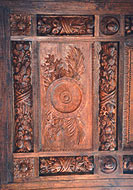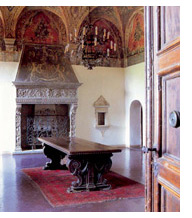| 1 / How to Get Started 2 / Focus on Components of Form 3 / Exercise Your Creativity |
Focus on your Intuition. Observe design components of your style collection.
What types of shapes are present? Is there a set of common shapes? Draw the present shapes.
 List the types of materials most represented. Are they
masonry, wood, metal, synthetic (glass, plastics), fabric, leather, paper?
What is characteristic of the quality? What is the choice of materials
(a good choice-value and durability worth the initial and lifetime costs)?
What is the workmanship of the materials? Focus on hard and soft items
-- what are your choice materials?
List the types of materials most represented. Are they
masonry, wood, metal, synthetic (glass, plastics), fabric, leather, paper?
What is characteristic of the quality? What is the choice of materials
(a good choice-value and durability worth the initial and lifetime costs)?
What is the workmanship of the materials? Focus on hard and soft items
-- what are your choice materials?
Review the styles and details of the windows, floors, doors, stairs, columns, mantels, furniture, fireplaces, and ceilings. These are the architectural elements of the space (for interior design purposes). What are the construction techniques, and are they appropriate for the intended use? Are things well-built? Is the construction visually pleasing and functional?
Identify the architectural elements. Do they match the overall structure? Look for consistency of contemporary, historic, regional or thematic presentation. This gives vital clues to your real decorative style solutions.
What colors are predominant in your collection? Write them down. Are you attracted to a series of different colors or a varying saturation of the same color? What are the prominent colors? Is the color palate broad or defined? What combinations of colors are present? What are the most prominent hues?
These answers will help indicate your sense of color, humor and mood for interiors.
 Look at the absolute size of the objects
(furniture, art, decorative accessories, etc.) and spaces in your interiors.
Is the size appropriate to use? Are the proportions visually appealing?
Are the dimensions symmetric, asymmetric, balanced or proportional? Is
the furniture massive in an immense space or compact? Are the rooms expansive
or intimate and compartmentalized?
Look at the absolute size of the objects
(furniture, art, decorative accessories, etc.) and spaces in your interiors.
Is the size appropriate to use? Are the proportions visually appealing?
Are the dimensions symmetric, asymmetric, balanced or proportional? Is
the furniture massive in an immense space or compact? Are the rooms expansive
or intimate and compartmentalized?
All of these answers are the keys to your design style. These components will help you form a design concept that is the critical basis for your interior design project.
In the next issue, we will talk about Design Concepts -- Harmony, Balance, Unity, Rhythm, Scale, Emphasis, Variety, Contrast, Pattern and Ornament. By understanding these elements and their relationships with form, you will possess the designing basics used by professionals to create remarkable interiors. We will study extraordinary examples of interior design and break down the components of form and concept to explain why and how the design works!
Go to Focus on Florence for a more in-depth look at how art, history, nature and tradition influence design
Go to Tiles and Textures for today's resources that provide these materials and elements
Subscribe to our free and extremely informative newsletter. We would love to have your comments at: mail@designintuit.com
Welcome / What We're About / Focus on Florence / Marco Polo's Quest / Michelangelo's Den / Great Sites & Sources / Reading / Tiles & Textures / Tools & Terms / Contact Us
This site design and text © DesignIntuit, 2005